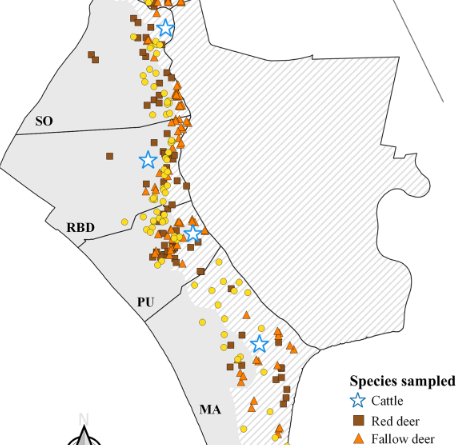Survey of Culicoides-borne bluetongue and Schmallenberg viruses at the wildlife-livestock interface in Doñana National Park (Spain)
Abstract
A cross-sectional study was carried out to assess the circulation of bluetongue virus (BTV) and Schmallenberg virus (SBV) within the wild and domestic ungulate host community in Doñana National Park (southwestern Spain). A total of 440 animals, including 138 cattle, 102 red deer (Cervus elaphus), 101 fallow deer (Dama dama) and 99 wild boar (Sus scrofa), were sampled in 2015 during the seasonal peak of Culicoides spp. (summer–autumn). Serum and spleen samples were analysed to detect exposure (using commercial blocking ELISAs) and infection (by RT-PCR), respectively, to BTV and SBV. Cattle were not tested by BTV-bELISA because all were previously vaccinated against BTV serotypes 1 and 4. High BTV seroprevalences were found in red deer (97.0%) and fallow deer (64.7%). Antibodies against SBV were detected in 37.0% of cattle, 16.8% of red deer, 23.5% of fallow deer and 2.0% of wild boar. Thirty-eight of the 203 deer (18.7%; 17 red deer and 21 fallow deer) were co-exposed to both viral agents. BTV-4 RNA was confirmed in four red deer and two fallow deer. SBV RNA was found in two fallow deer. Co-infections were not detected. Our results indicate high exposure, widespread distribution and active circulation of BTV and SBV in the ruminant community in the study area. We provide additional evidence for the potential role of wild cervids as reservoirs of these Culicoides-borne viruses in two different epidemiological scenarios: with vaccination (BTV) and without vaccination (SBV) of sympatric livestock. This study highlights the importance of wildlife surveillance, particularly of cervid species, for the proper execution of control programmes of Culicoides-borne diseases in extensively reared livestock.




